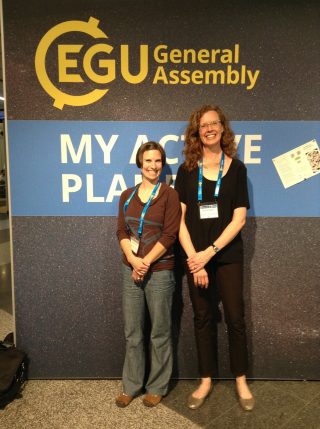
EGU 2016 General Assembly as for the past years was a success with almost 14.000 participants from 106 different countries: check the feedback page for more details.
Concerning our session dedicated to Earth sciences and Art we sure can state that it was an intense session full of new ideas. We had the pleasure to have again as first speaker During the oral presentation, it was appreciable to have in a couple of cases both the scientist and the artist presenting their contribution. It was the case of Melissa Grey curator of Paleontology at the Jogging Fossil Cliffs in Canada and Janine Rogers, English Professor at Mount Allison University. They presented a work concerning an upcoming exhibit for the Jogging Fossil Centre (EGU2016-4484). Also Space scientist Hugh Mortimer of the RAL (Rutherford Appleton Laboratory) in Oxford during his presentation gave the scene to Alexander Whitley a choreographer of the AWDC Company to illustrate how the science of the Sun will be presented in a collaborative approach among Science, Music and Dance (EGU2016-17215).
Poster session was also remarkable, and it was of great importance the presence of many Italian colleagues, since in our country we are still moving the first steps towards and interdisciplinary approach between Art and Science. For instance, we lack the figure of the Artist-in- residence in the Scientific Institutions, that is present in several countries, in Europe and outside. Among the posters a couple were dedicated to the role of photography in describing geological landscapes (EGU2016-17864) and in underlying environmental problems as the pole melting ice due to global warming (EGU2016-18239); The Rome INGV colleagues presented a work concerning the importance of a well oriented graphic in order to communicate geosciences in a clear an appropriate way (EGU2016-7183); other original works show the use of art in communicating the beauty of a microscopic world as the one of some crickets of central italy: their acoustic emission were studied in detail and then transformed with the help of a musician in a charming composition (EGU2016-7514). Among all the other interesting works, some were dedicated to the geology of Italy, with a multidisciplinary approach to the landscapes of Central Italy (EGU2016-3911). We had the pleasure to have also the American Author and Geologist Ann C. Pizzorusso presenting her wonderful book Twittando Da Vinci, a book that explores how Italy’s geology has affected its history, art, religion, medicine and culture (EGU2016-1262). And we welcomed again our friends and colleagues from Japan this time presenting a work where the popular traditions of two countries, Japan and Germany, were compared and put in relations with the seasonal transition in meteorology (EGU2016-3069).
These are just some of the contributions presented at EGU 2016 EOS18 session. We will keep on posting about the two sessions (EGU 2015 – 2016).
Thank you for your participation!
The Conveners of the EGU 2016 EOS 18 Session